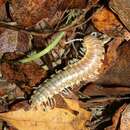pms
nòm ant ël fil


Xystocheir dissecta is one of nine millipede species belonging to the Californian genus Xystochier (family Xystodesmidae). Xystocheir dissecta lives in loose dirt, decaying logs and leaf litter (especially oak), and under rocks, and can be found around houses in the Bay area.They come out to forage in the fall and winter and can be easily seen at night from up to 10 feet away if caught with a uv light, as their cuticle fluoresces (Young 2010). They are more difficult to find during the day because their coloration is muted for camouflage - although species in other closely related genera have bright aposematic markings to warn predators of their toxicity.Individuals grow about 30 mm long and 5.5-6 mm across in width.They are common and found continuously along the coast and about 95 km (60 miles) eastward to the Sierra foothills in Mendocino, Amador, Stanislaus and northern Monterey counties. Xystocheir dissecta is a remarkably diverse species and includes many races, grades and three subspecies, showing a full continuum along the speciation process (Shelley 1995a, b; Shelley 1996).
For a video showing an individual glowing at night, see this “Bay Citizen” link.
Xystocheir dissecta is one of nine millipede species belonging to the Californian genus Xystochier (family Xystodesmidae).This milipede lives in loose dirt, decaying logs and leaf litter (especially oak) and under rocks.They are common and found continuously in a small discrete region along the coast and about 95 km (60 miles) eastward to the Sierra foothills in Mendocino, Amador, Stanislaus and northern Monterey counties, including in dirt around houses in the Bay area.They come out to forage in the fall and winter and can be easily seen at night from up to 10 feet away if caught under a uv light, as their cuticle fluoresces (Young 2010).Because their coloration is muted for camouflage they can be difficult to find during the day, in contrast to other closely related milipede genera which have bright aposematic markings to warn predators of their toxicity.Individuals grow about 30 mm long and 5.5-6 mm across in width.Xystocheir dissecta is a remarkably diverse species and includes many races, grades and three subspecies, showing a full continuum along the speciation process (Shelley 1995a, b; Shelley 1996).
For a video showing an individual glowing at night, see this “Bay Citizen” link.
Xystocheir dissecta is a species of flat-backed millipede in the family Xystodesmidae. It is found in North America.[1][2][3][4]
These three subspecies belong to the species Xystocheir dissecta:
Xystocheir dissecta is a species of flat-backed millipede in the family Xystodesmidae. It is found in North America.